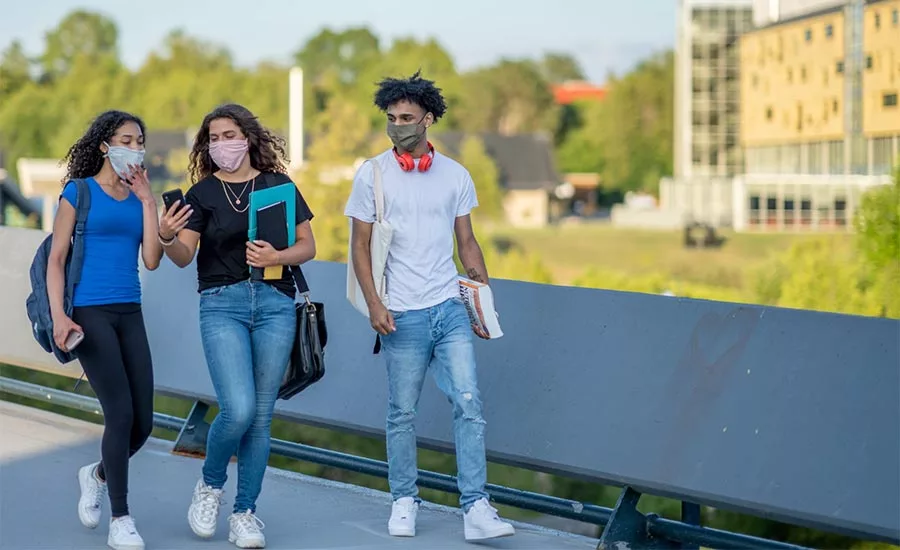Security Strategies
Campus safety challenges in a post-2020 world, strategies for success
The year 2020 presented society and the campus community with very difficult and unique challenges. Let’s take a look at a practical, fiscally responsible approach that security leaders can implement to maintain traditional services and respond to unique challenges, all while preparing for the unexpected.

Campus police should prepare for the unexpected with tabletop exercises, trainings and response plans.
fstop123 / Royalty-free via Getty Images
The year 2020 presented society and the campus community with very difficult and unique challenges; the COVID-19 pandemic, civil unrest, protests, counter-protests, distrust of police amongst the minority community, riots and the escalating “right against the left” mentality. Additionally, the 2020 U.S. presidential election has polarized the country more than any other time since the U.S. Civil War.
Campus Police and security teams are tasked with not only providing a professional and measured response to these volatile and politically charged issues, but must still maintain traditional, expected and valuable services, all within budgets that, for many campus security teams, will probably not be increasing.
So, let’s take a look at a practical, common sense, fiscally responsible approach that we as security leaders can implement to maintain traditional services and respond to unique challenges, all while preparing for the unexpected.
1. Be prepared for the unexpected.
Take a futuristic approach to campus safety planning. Don’t ignore the warning signs of what issues and problems lie ahead and how they may affect campus daily life and campus safety. Be aware of political, fiscal and social trends. For example, the U.S. Capitol Police were highly criticized for not “planning ahead” for what occurred when violent protestors stormed the U.S. Capitol on January 6, 2021.
In terms of campus safety and security “an ounce of prevention is worth a ton of cure.” Although no one has a crystal ball, it’s important to develop a forward-thinking safety and response mindset among your security team.
Don’t ignore early warning signs or threats. Read the daily intelligence briefings published by federal and local law enforcement, and partner with law enforcement and the emergency management community. Follow trusted national and local news sources to get an indication of what problems both short term and long term are on the horizon and develop response plans for what may occur. For example, far-sighted safety departments were purchasing PPE’s and making sure pandemic protocols were in place as soon as the COVID-19 pandemic was on the horizon in early 2020, before national shutdowns.
2. Be realistic.
Frequently ask yourself and your security staff, “What if?” What if this particular type of incident occurs, how will we respond? What do we need? Do we have the resources? Do we have the training?
Although funds are not inexhaustible, it is easier to justify requesting funds if they are attached to a reasonable response to a realistic threat. One of the best ways to ensure that funds will be available is to attach funding requests to several different emergencies with proposals to use these funds for whatever may occur.
Sometimes, federal or state funds will be released to cover the cost of declared disasters, however, it is not ideal to rely solely on these funds. Very importantly, be straightforward, realistic and justify all budgeting requests. If you are merely padding your security budget with a “wish list,” you may lose credibility within your institution.
3. Have a plan (and be flexible).
Make plans for what you and your campus police staff may actually need in the future. First, make an overall assessment of what personnel, equipment and other resources will be needed for any man-made or natural disaster. This planning typically includes hurricanes, storms, pandemics, active shooters, civil unrest and mass casualty events, however, be as open minded and “future predictive” as possible to foresee any other events that may occur.
Qualified personnel, proper equipment and realistic training are the bedrock of a campus safety department so take inventory of what you have, and plan for the personnel, equipment and training that will be needed.
In addition, develop and document response protocols and procedures. Policies and procedures accomplish two very important goals. First, they act as guides to why, how and when we respond. Second, and very importantly, they demonstrate a documented commitment to safety.
Be sure to develop response protocols that are specific enough to cover most events yet provide enough flexibility to respond to the unique characteristics of each different event. Research and borrow response plans from other institutions. Most campus safety leaders will share their protocols with other campus safety leaders and will gladly ask them to return the favor. Attend Campus Safety conferences, read the trade magazines, and research qualified Internet sources for various safety plans and protocols.
Provide realistic training that focuses on skills improvement, decision making and provides confidence to the officers and overall campus community. Realistic hands-on training also stresses the importance of leadership and developing leaders that can make decisions on the fly. Not all responses to crises work perfectly, so it is important to have a back-up plan and a back-up plan to the back-up plan.
Try to be as cost-effective as possible without sacrificing safety. Incorporate training for emergencies into routine training programs. Plan to use equipment that is already purchased and available. For example, crowd control equipment such as fencing, bullhorns and gates that are used for large passive crowds at sporting events can also be used for civil demonstrations and separating hostile crowds from other persons or buildings. Campus safety personnel can partner with university medical programs for PPE’s and medical supplies. Partnering with local law enforcement and fire rescue for mutual aid increases the number of first responders and can be cost effective.
4. Don’t forget the basics.
Be prepared and be ready for major events, however, don’t let the fear of the “big one” overshadow the importance of day-to-day campus safety responsibilities. Most campus safety needs are found in the daily tasks of assisting the public, preventing crime and responding to calls for service. A professional, well-trained, well-equipped, campus safety force that is focused on service, prevention and response, yet is fully prepared for the unexpected is the ultimate goal.
5. Prepare for the ‘after’.
Just as important as preparation, training and response is what occurs when the crisis is over. After an event, incident or crisis, campus safety personnel and other campus leaders should meet and hold a debriefing to discuss the response plan’s successes and failures, lessons learned and suggestions for improvement. Be sure to include all stakeholders and subject matter experts in this process because the more improvement that happens during a debriefing (post-crisis), the better the response during the next crisis.
Remember not all crises can be avoided, however, the negative effects may be lessened with prediction, planning, training, prevention and proper response.
Looking for a reprint of this article?
From high-res PDFs to custom plaques, order your copy today!







